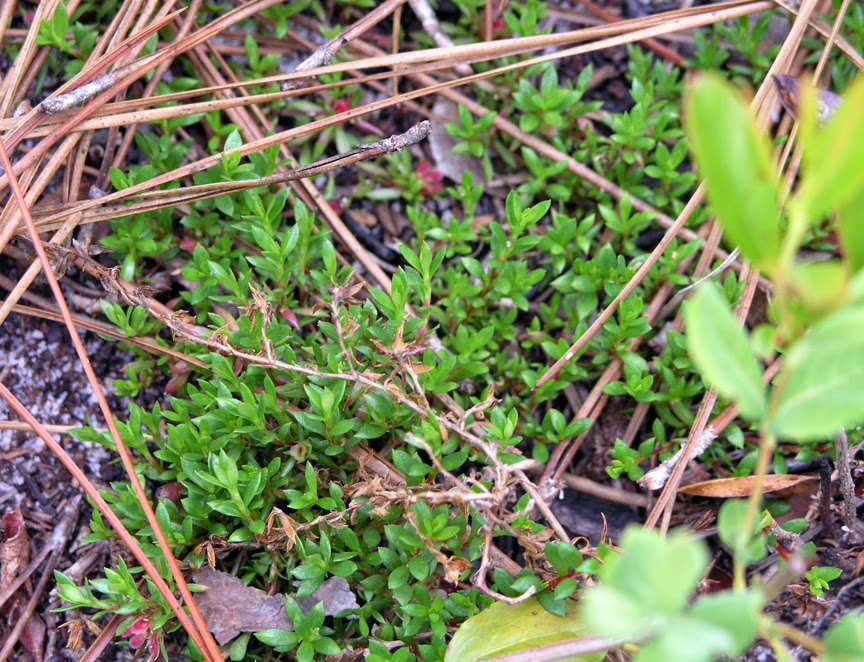 |
Looking towards West Virginia from Reddish Knob.
|
Last Sunday I joined the Virginia Native Plant Society (VNPS) group on an excursion to Reddish Knob, VA. This is a part of Virginia that I'd never seen before and at 4,101 ft. one of the highest elevation points in the state; the flora in this area and the views promised to be outstanding.
 |
The view south, Shenandoah Mountain.
|
The day was cloudy and cool, and the moment I got on I-81 it started to rain lightly. I had my three-season jacket with me but had opted to leave my rain jacket at home, in order to lighten my backpack--I hoped I wouldn't regret my decision later on. Thankfully the rain stopped by the time I reached the exit at Harrisonburg.
Driving on the back roads through the small towns in this area before finding Briery Branch Road, I skirted around at least a dozen horse and buggy carriages--this is the heart of Mennonite country in Virginia--they were probably heading home from Sunday services.
 |
Old sugar maple (Acer saccharum) trunk
|
Our meeting spot at the Hone Quarry picnic area was by a stream in a rich wood, and we did a bit of botanizing here before driving up to Reddish Knob. Under very large sugar maples, beech, birch and hemlock we found spurred violets (Viola rostata), miterwort (Mitella diphylla) and one very dense growth of one-flowered cancer root (Orobanche uniflora).
 |
Spurred violet (Viola rostata)
|
 |
Miterwort (Mitella diphylla) among ferns
|
 |
Cluster of one-flowered cancer root flowers (Orobanche uniflora)
|
As the name of this species implies, there is only one flower per plant, so this cluster represents many plants growing very close together. The only part of this parasitic plant that grows above ground is the flowering stem. The forest floor elsewhere was thick with sweet white violets, Solomon's seal,
Geum, sweet Cicely, Hepatica, ferns, bluets, sedums, wild yam and ebony
spleenwort.
 |
Wild yams (Dioscoria villosa) in rich woods
|
After we had surveyed this area, we set out as a car caravan to drive up the mountain, pulling out by the side of the fairly narrow road to look at the confabulation of flora on the banks. At our first stop a most remarkable display of Lyre-leaved sage in bloom greeted us, growing among bowman's root, whorled loosestrife, yellow-eyed grass, bracken ferns, mountain laurel and enormously tall plantain-leaved pussytoes.
 |
Walk leader Sally Anderson ID's plants on the bank.
|
 |
Lyre-leaved sage (Salvia lyrata) with plantain-leaved pussytoes (Antennaria plantaginifolia)
|
 |
Bowmans root (Gilleniua trifoliata) with lyre-leaved sage
|
 |
Whorled loosestrife (Lysimachia quadrifolia)
|
 |
Eastern yellow-eyed grass (Hypoxis hirsuta)
|
There wasn't much space for road traffic to pass by us, and as the last
car in line, I could see several cars and trucks piling up on our tail, growing impatient
with our pace. We finally reached a place where these could pass us so we could continue at our leisurely pace--I couldn't believe how fast the locals barrel around these curves!
At our next few stops we encountered a number of different arrays of flora on the steep road banks as we climbed: tree-sized pinxter azaleas and lovely dogwoods on the down-sloping bank to our left; starry campion, mountain laurel, wood vetch, violets, Carolina pinks, blueberries and iris on the upward slope to our right.
 |
Pinxter azalea (Rhododendron periclymenoides)
|
 |
Bird's foot violet (Viola pedata)
|
 |
Bank filled with Carolina pinks (Silene carolinana)
|
 |
Close-up of Carolina pink
|
 |
Dwarf iris (Iris verna)
|
As we rose, the clouds began to clear, and at times patches of sunlight illuminated the banks. Bird's foot violets, mountain bellwort, blueberries, and deerberries appeared.
 |
The higher slopes.
|
 |
Mountain bellwort (Uvularia puberula)
|
 |
Blueberries (Vaccinium corymbosum)
|
At another curve with wider pull-off we walked around a bit and found blueberries and huckleberries, mountain fetterbush, some gaywings, trillium and quite a number of pink lady slipper orchids. These were much smaller than the ones I've seen in Fort Valley but every bit as lovely.
 |
Gaywings (Polygala pauciflora)
|
 |
Mountain fetterbush (Pieris floribunda)
|
 |
Pink lady slipper orchids (Cypripedium acaule)
|
 |
Huckleberries (Gaylusia sp.)
|
As we ascended, it was as if spring were unwinding backwards--the foliage was just emerging at these heights. We stopped briefly at a bend, the intersection with FR 85, and saw a hillside carpeted with interrupted fern just at the stage when the spore-bearing fronds (sporangia) were maturing. I climbed down the steep bank for a closer look.
 |
Hillside with interrupted fern (Osmunda claytoniana)
|
 |
Interrupted fern with sporangia
|
 |
Close-up of spore-bearing fronds
|
These curious spore-bearing fronds occur not on the underside or edges of the leaves as in many ferns, but in the middle of the fronds, and fall off after they ripen, thence interrupting the frond. After this last stop, it was time to move toward Reddish Knob--it was almost five o'clock. We drove past a couple of lovely stands of wild lupines without stopping.
The last part of the road leading to the knob was very narrow and steep, and began to reveal the incredible views all around. The small parking area at the top was covered in graffitti--college kids from Harrisonburg like to drive up here to party.
 |
VNPS group at Reddish Knob
|
On the way back down, I had to maneuver to allow another car coming up the narrow road to pass--there was no way for either of us to turn around. Then I stopped to photograph the lupines before heading home.
 |
Sundial lupines (Lupinus perennis)
|




































